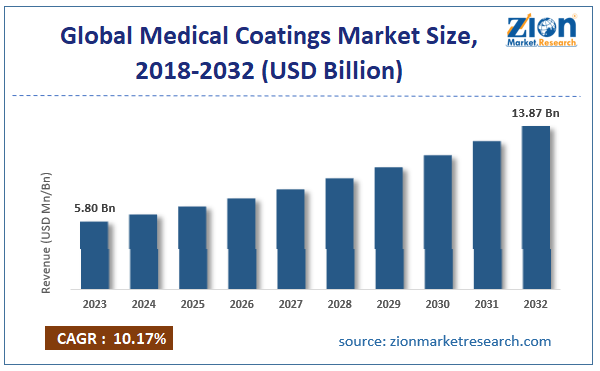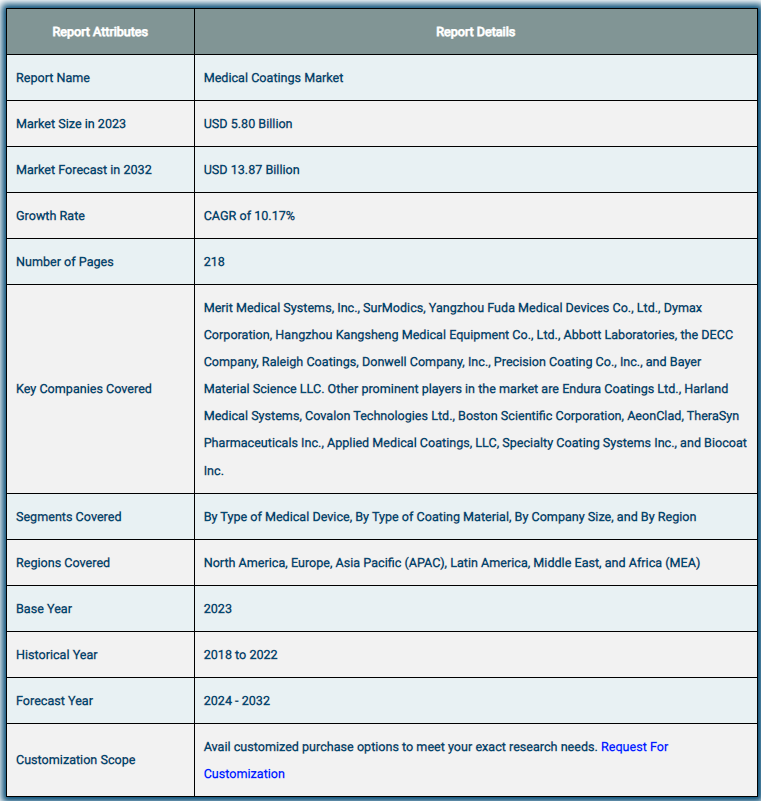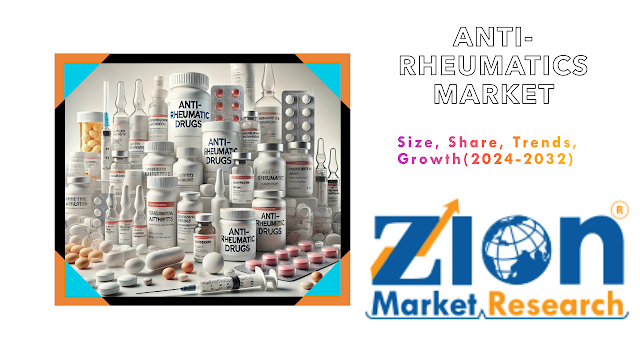💊Medical Coatings Market Size, Share, Growth, Trends, and Forecast 2032

The size of the worldwide Medical Coatings market is expected to grow at a CAGR of roughly 10.17% between 2024 and 2032, with earnings of around USD 5.80 billion in 2023 and over USD 13.87 billion in sales by 2032.
✈👉Get a Free Sample: 🚀https://www.zionmarketresearch.com/sample/medical-coatings-market
Introduction
The medical coatings market plays an essential role in advancing healthcare technology by enhancing the performance, safety, and functionality of medical devices. Medical coatings are applied to devices and implants to provide properties such as biocompatibility, durability, antimicrobial protection, and enhanced lubricity. These coatings are critical in medical devices like catheters, stents, implants, and diagnostic equipment, driving innovation in the healthcare industry. This article explores the current state of the medical coatings market, key drivers, challenges, market segmentation, and emerging trends.

Overview of the Global Medical Coatings Market
For medical gadgets to function properly, they require specialized protection. These medical equipment are rendered useless and ineffective by bodily fluids, electrical charges, infection, and dampness. Several substrate types, such as silicone rubber, glass, ceramics, metals, and plastics, are sterilized by medical coatings. Physical-mechanical, electrical barrier, moisture, chemical, and tribological qualities are all included in the term “physico-mechanical coating.
The global market for coatings on medical devices is expected to increase steadily during the projected period because to the rising prevalence of these devices and the associated elevated risk of infections. Class III devices currently account for the majority of the medical device coating market overall among all the other categories of coated medical devices. High-risk medical equipment such as pacemakers, defibrillators, cochlear implants, renal stents, and coronary stents are classified as class III devices.
Medical coatings are thin layers applied to the surfaces of medical devices and instruments to improve performance and safety. These coatings can serve a wide range of functions, such as reducing friction (lubricity), preventing infections (antimicrobial coatings), enhancing biocompatibility, and facilitating drug delivery.
The global medical coatings market has seen substantial growth in recent years, largely driven by advancements in medical technology, the rise in demand for minimally invasive surgeries, and the growing prevalence of chronic diseases requiring long-term medical devices like implants. Medical coatings are also crucial in the development of wearable medical devices and diagnostics, making them a key component in the broader healthcare market.

Growth Factors for the Global Medical Coatings Market
Medical coatings reinforce the product surface function and maximize the performance of medical devices. These coatings provide coating uniformity, wetting, and surface covering while also helping to reduce friction between tissues and devices. The necessity for non-stick coatings on biocompatible, electrical insulating, molded, and other materials on the majority of medical equipment is driving the growth of the medical coatings market. The demand for medical coatings on the international market is rising as a result of the medical industry’s rapid expansion. The demand for life-saving equipment is particularly strong in emerging nations, which supports the expansion of the medical coatings industry. On the other hand, a product’s age, poor shelf life, availability of alternatives, growing expenses, and fluctuating government rules could prevent the market from expanding.
✈👉Directly Purchase a copy of the report with TOC: 🚀https://www.zionmarketresearch.com/toc/medical-coatings-market
Market for Medical Coatings: Report Extent

Segmentation of the Global Medical Coatings Market
Based on type, geography, and application, the medical coatings market is divided into two segments worldwide.
The market is divided into implants, medical devices, medical equipment and instruments, and other categories based on the application.
The type sector is divided into antimicrobial coatings, lubricants, and hydrophilic coatings.
North America, Europe, Asia-Pacific, Latin America, and the Middle East and Africa make up the market’s diverse regions.
Global Market for Medical Coatings: Regional Snapshot
In terms of market share, North America led the medical coatings industry, followed by Asia Pacific and Europe. It is anticipated that the medical coatings market in Asia-Pacific will grow. Due to their high levels of consumption and established medical industries, developing countries in the Asia-Pacific area including China and India are anticipated to present a profitable market for medical coatings. In the Asia Pacific region, Australia, Malaysia, Hong Kong, Japan, New Zealand, Indonesia, Korea, and Vietnam are among the other nations with significant medical coating usage rates. Latin America is expected to drive the medical coatings market in the future due to its strong economic development and the region’s fast-growing medical industries. In Latin America, the top three countries for medical coatings consumption are Brazil, Argentina, and Peru. In order to introduce superior quality medical coatings, many companies in Asia Pacific and Latin America are heavily investing in research and development.
Key Market Segments
The medical coatings market can be segmented based on the type of coating, application, material, and region.
- By Coating Type:
- By Application:
- By Material:
- By Region:
Market Drivers
Several factors are driving the growth of the medical coatings market:
- Rising Demand for Minimally Invasive Surgeries: Minimally invasive surgeries, which require precise, low-friction medical devices, are becoming more common as they reduce recovery times and risks for patients. Hydrophilic coatings on devices used in these procedures, such as guidewires and catheters, are in high demand.
- Increasing Prevalence of Chronic Diseases: The growing incidence of chronic diseases such as cardiovascular conditions, diabetes, and arthritis has fueled the need for long-term implantable medical devices. Medical coatings enhance the functionality and safety of these devices, ensuring they remain effective within the body for extended periods.
- Growing Focus on Infection Control: Hospital-acquired infections (HAIs) are a significant concern in healthcare settings, prompting greater demand for antimicrobial coatings that prevent bacterial growth on medical devices, surgical instruments, and implants.
- Technological Advancements in Coating Materials: Innovations in coating technologies, such as the development of advanced polymers, biocompatible materials, and nanotechnology, are creating opportunities for new applications. These advancements enable coatings to be more durable, flexible, and tailored to specific medical needs.
- Expansion of Wearable Medical Devices: The rise of wearable health monitoring devices, such as heart rate monitors and glucose sensors, has increased the need for protective and functional coatings. Hydrophobic and antimicrobial coatings are commonly used in these devices to improve durability and user safety.
Challenges in the Market
Despite the promising growth, the medical coatings market faces several challenges:
- Stringent Regulatory Requirements: The medical device industry is heavily regulated, and coatings applied to medical devices must meet stringent safety and performance standards set by regulatory bodies such as the U.S. FDA and the European Medicines Agency (EMA). The lengthy and costly approval processes can slow down the introduction of new coating technologies to the market.
- High Costs of Advanced Coatings: Advanced coatings, such as drug-eluting and antimicrobial coatings, often involve complex manufacturing processes and expensive raw materials. These high costs can limit their adoption, particularly in developing regions where healthcare budgets are constrained.
- Biocompatibility Issues: While coatings are designed to be biocompatible, some materials may still provoke adverse reactions in patients. Biocompatibility testing and validation are crucial, but failures in this area can lead to recalls or the need for redesigns.
- Durability and Wear Resistance: In some applications, especially for implantable devices, the durability and long-term performance of medical coatings are critical. Coatings that wear off or degrade over time can lead to device failure, complications, or the need for additional surgeries.
Emerging Trends
Several trends are shaping the future of the medical coatings market:
- Development of Multifunctional Coatings: Coatings that combine multiple functionalities, such as antimicrobial, anti-thrombogenic, and drug-eluting properties, are gaining traction. These multifunctional coatings improve patient outcomes by addressing several challenges simultaneously, such as infection control and localized drug delivery.
- Nanotechnology in Coatings: Nanotechnology is being increasingly used to develop medical coatings with enhanced performance. Nanostructured coatings can provide superior durability, enhanced biocompatibility, and improved control over drug release in drug-eluting devices.
- Sustainability and Biodegradable Coatings: There is a growing focus on developing coatings that are environmentally sustainable and biodegradable, particularly for single-use medical devices. Biodegradable coatings reduce the environmental impact of disposable devices while ensuring they perform effectively during use.
- Smart Coatings for Real-time Monitoring: The rise of smart medical devices is leading to the development of coatings that can provide real-time monitoring or feedback. These coatings can detect changes in the body’s environment, such as pH or temperature, and respond by releasing drugs or triggering alerts.
- Growth in Homecare Devices: As healthcare systems shift towards more home-based care, the demand for coated medical devices used in homecare settings is expected to increase. Coatings that improve ease of use, durability, and hygiene are particularly relevant for devices like home dialysis machines, glucose monitors, and wearable sensors.
Competitive Landscape
The medical coatings market is highly competitive, with major players focusing on product innovation, strategic partnerships, and mergers to strengthen their positions. Key players in the market include:
- DSM Biomedical
- SurModics, Inc.
- Covalon Technologies Ltd.
- Hydromer Inc.
- AST Products, Inc.
- Harland Medical Systems
- Precision Coating Company, Inc.
- Biocoat, Inc.
- Specialty Coating Systems, Inc.
These companies are investing in research and development to introduce advanced coating technologies that offer enhanced performance and biocompatibility, addressing the evolving needs of the medical device industry.
Future Outlook
The future of the medical coatings market looks promising, with continuous advancements in technology and a growing demand for high-performance coatings across various medical applications. The increasing adoption of minimally invasive surgeries, the rise of smart medical devices, and the focus on infection prevention are expected to drive the market forward.
North America currently dominates the market due to the presence of well-established healthcare infrastructure, significant investments in medical device innovation, and strict regulatory standards. However, emerging markets in Asia-Pacific, particularly China and India, are anticipated to witness rapid growth due to the increasing demand for advanced healthcare technologies and expanding medical manufacturing capabilities.
Conclusion
The medical coatings market is poised for steady growth, driven by innovations in coating materials, the rising demand for minimally invasive devices, and the need for infection control. As the medical device industry continues to evolve, the development of advanced coatings with multifunctional properties and enhanced biocompatibility will be key to meeting the demands of modern healthcare.
For manufacturers and investors, staying ahead of regulatory requirements and focusing on the development of durable, cost-effective, and safe coatings will be critical to succeeding in this competitive market.
✈👉Enquiry for buying: 🚀https://www.zionmarketresearch.com/inquiry/medical-coatings-market
Browse other trend reports:
Clean Label Ingredients Market
Contact Us:
Zion Market Research212
USA/Canada Toll Free: 1 (855) 465–4651
Newark: 1 (302) 444–016611\
Web: https://www.zionmarketresearch.com/
Blog: https://zmrblog.com/

Comments
Post a Comment